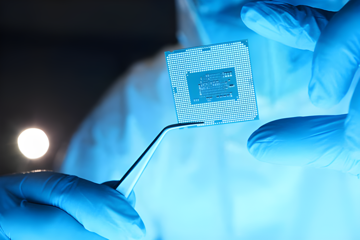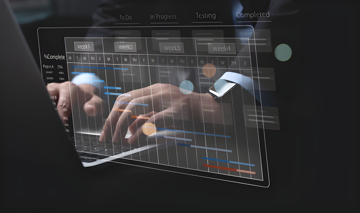PIC Serial Communication: UART, SPI, and I2C Explained
Mastering Wireless Communication: PIC, RF & Bluetooth
Wireless communication can significantly enhance the capabilities of any embedded system by allowing remote data transfer, device control, and interaction with other wireless-enabled devices. In this tutorial, we will explore the essential concepts required to interface PIC microcontrollers Introduction to PIC: Exploring the Basics of Microcontroller ArchitectureExplore the core principles of PIC microcontroller architecture, including Harvard design, RISC processing, and efficient memory organization. with common RF and Bluetooth modules. Our focus will be on the fundamental principles and practical steps to establish a reliable wireless link, ensuring that you can readily apply these concepts to your own projects.
Introduction to PIC: Exploring the Basics of Microcontroller ArchitectureExplore the core principles of PIC microcontroller architecture, including Harvard design, RISC processing, and efficient memory organization. with common RF and Bluetooth modules. Our focus will be on the fundamental principles and practical steps to establish a reliable wireless link, ensuring that you can readily apply these concepts to your own projects.
Introduction to Wireless Communication on PIC🔗
Wireless modules extend the reach of a PIC-based design without the need for wired connections. Whether it's a simple 433 MHz RF link or a more sophisticated Bluetooth module, your PIC microcontroller Introduction to PIC: Exploring the Basics of Microcontroller ArchitectureExplore the core principles of PIC microcontroller architecture, including Harvard design, RISC processing, and efficient memory organization. must handle the communication protocols required by these devices.
Introduction to PIC: Exploring the Basics of Microcontroller ArchitectureExplore the core principles of PIC microcontroller architecture, including Harvard design, RISC processing, and efficient memory organization. must handle the communication protocols required by these devices.
Key Advantages of Adding Wireless Functionality:
- Remote data monitoring and control without physical cables.
- Enhanced flexibility and mobility in applications like wearables and IoT
 Scalable Architecture for Internet of Things (IoT) ApplicationsExplore best practices for developing scalable IoT systems using PIC microcontrollers, emphasizing hardware, protocols, security, and modular design. devices.
Scalable Architecture for Internet of Things (IoT) ApplicationsExplore best practices for developing scalable IoT systems using PIC microcontrollers, emphasizing hardware, protocols, security, and modular design. devices. - Support for multiple protocols (Bluetooth, RF transceivers) for various use cases.
In this tutorial, we'll focus on two popular approaches:
1. RF Modules: Typically low-cost, these modules often operate in ISM bands (e.g., 433 MHz or 2.4 GHz) and can be used for simple point-to-point links.
2. Bluetooth Modules: Widely used in consumer electronics, they facilitate easier device pairing with smartphones, tablets, and PCs.
Understanding RF Modules🔗
When working with radio frequency Generating Audio with PIC Timers and PWMExplore how to configure PIC timers and PWM for audio signal generation, including hardware setup, duty cycle adjustments and simple tone creation. (RF) modules, you may encounter either simple transmitter/receiver pairs or more advanced transceiver modules. These modules typically:
Generating Audio with PIC Timers and PWMExplore how to configure PIC timers and PWM for audio signal generation, including hardware setup, duty cycle adjustments and simple tone creation. (RF) modules, you may encounter either simple transmitter/receiver pairs or more advanced transceiver modules. These modules typically:
- Operate using simple Serial Peripheral Interface (SPI) or basic digital pins
 Mastering Digital I/O on PIC MCUs with Practical ExamplesLearn hands-on techniques for configuring and using digital I/O pins on PIC microcontrollers to control LEDs, sensors, and more in practical projects..
Mastering Digital I/O on PIC MCUs with Practical ExamplesLearn hands-on techniques for configuring and using digital I/O pins on PIC microcontrollers to control LEDs, sensors, and more in practical projects.. - Have limited data rates compared to Wi-Fi or advanced systems.
- Offer a straightforward means for unidirectional or bidirectional communication depending on module type.
Below is an example of a commonly encountered architecture for an RF transceiver module (like those based on 2.4 GHz chips):
| Component | Function |
|---|---|
| RF Chip (e.g., nRF24) | Handles wireless frequency generation and data frames |
| Antenna | Transmits/receives the RF signals |
| SPI Interface | Connects module to PIC for command/data exchange |
| Power Regulation | Ensures stable voltage supply for RF operations |
Hardware Interfacing
Most RF modules require:
- VCC (commonly 3.3 V, though some use 5 V – check your module’s specs).
- GND (common reference ground with the PIC).
- SPI pins (MISO, MOSI, SCK, and a chip-select line).
An example connection between a PIC microcontroller Introduction to PIC: Exploring the Basics of Microcontroller ArchitectureExplore the core principles of PIC microcontroller architecture, including Harvard design, RISC processing, and efficient memory organization. and an RF module using SPI might look like this:
Introduction to PIC: Exploring the Basics of Microcontroller ArchitectureExplore the core principles of PIC microcontroller architecture, including Harvard design, RISC processing, and efficient memory organization. and an RF module using SPI might look like this:
Software Setup
1. SPI Initialization: Configure the PIC's SPI module (clock polarity, phase, and speed) to match the RF module’s requirements.
2. Module Configuration: Send initialization commands to set frequency Generating Audio with PIC Timers and PWMExplore how to configure PIC timers and PWM for audio signal generation, including hardware setup, duty cycle adjustments and simple tone creation. channels, data rate, and power level.
Generating Audio with PIC Timers and PWMExplore how to configure PIC timers and PWM for audio signal generation, including hardware setup, duty cycle adjustments and simple tone creation. channels, data rate, and power level.
3. Data Transmission: Load the transmit buffer and trigger a send operation; wait for the module’s status flags to confirm completion.
4. Data Reception: Continuously poll (or use an interrupt Implementing Interrupt-Driven Systems for Real-Time ApplicationsLearn to configure and optimize PIC microcontroller interrupts for real-time performance. Enhance responsiveness and efficiency using best practices.) to detect incoming packets from the RF module, and then read data from its FIFO buffer.
Implementing Interrupt-Driven Systems for Real-Time ApplicationsLearn to configure and optimize PIC microcontroller interrupts for real-time performance. Enhance responsiveness and efficiency using best practices.) to detect incoming packets from the RF module, and then read data from its FIFO buffer.
Interfacing with Bluetooth Modules🔗
Bluetooth modules (e.g., HC-05, HM-10) provide an easy way for your PIC-based system to communicate with smartphones or other Bluetooth-enabled devices. These modules typically implement a UART interface for data exchange.
Hardware Connections
Common I/O lines include:
- VCC (often 3.3 V, though certain Bluetooth modules can handle 5 V).
- GND shared with the PIC.
- TX (transmit) connected to the PIC’s UART RX pin.
- RX (receive) connected to the PIC’s UART TX pin.
- State/Key pins for special configuration modes (module-dependent).
A typical wiring diagram may appear as follows:
Configuring the PIC UART
Steps to Initialize UART on PIC:
1. Configure the baud rate to match your Bluetooth module's default setting (often 9600, 19200, or 115200 bps).
2. Set the data format (8-bit data, no parity, 1 stop bit).
3. Enable the UART transmit and receive modules in software.
Once initialized, any data you send via the PIC’s UART transmit register will appear on the Bluetooth module’s TX pin and vice versa.
Pairing and Testing
With many Bluetooth modules:
1. Power up the module and ensure it is discoverable.
2. On a smartphone or PC, scan for available Bluetooth devices and pair with your module (e.g., “HC-05”).
3. Use a serial terminal application on the PC/smartphone to open a connection. Characters typed in the terminal should be received by the PIC and vice versa.
Example Code Snippets🔗
Below is a simplified C-code snippet illustrating initialization of UART on PIC for a Bluetooth module at 9600 bps. This assumes a compiler setup for your specific PIC device (e.g., using XC8 Getting Started with MPLAB X and the XC8 CompilerSet up MPLAB X IDE and XC8 compiler for PIC programming with our comprehensive guide detailing installation, configuration, and debugging techniques.):
Getting Started with MPLAB X and the XC8 CompilerSet up MPLAB X IDE and XC8 compiler for PIC programming with our comprehensive guide detailing installation, configuration, and debugging techniques.):
#include <xc.h>
// Assume a default clock frequency and configuration bits are already set.
void UART_Init(void) {
// Set baud rate: For demonstration, assume Fosc = 8 MHz
// Baud Rate Generator settings will vary among PIC models.
TXSTA = 0b00100000; // Enable transmit, set high speed mode if desired
RCSTA = 0b10010000; // Enable serial port and continuous receive
BAUDCON = 0; // Standard baud rate control
// Calculate SPBRG for 9600 bps at Fosc = 8 MHz
SPBRGH = 0;
SPBRG = 51; // This value may differ based on your PIC and Fosc.
// Enable TX, RX pins (TRIS settings depend on your PIC)
}
void main(void) {
// Initialize the system, set up I/O, etc.
UART_Init();
while(1) {
// Example: Transmit a character
while(!TXIF); // Wait until transmit buffer is empty
TXREG = 'H';
// Add any state machine or data processing here.
}
}
For RF modules using SPI, the code structure can be similar-initializing SPI, followed by module-specific register writes and reads. Use the appropriate SSP or SPI registers to configure the clock frequency Low-Power Strategies: Maximizing PIC Battery LifeDiscover proven low-power strategies for PIC microcontrollers that maximize battery life through smart oscillator use, sleep modes, and efficient coding., polarity, and data order. Then you’d write data to the SPI buffer to command the RF module.
Low-Power Strategies: Maximizing PIC Battery LifeDiscover proven low-power strategies for PIC microcontrollers that maximize battery life through smart oscillator use, sleep modes, and efficient coding., polarity, and data order. Then you’d write data to the SPI buffer to command the RF module.
Best Practices and Troubleshooting🔗
1. Check Voltage Levels: Match the PIC’s logic voltage with the module’s voltage requirements. Use level shifters when needed.
2. Stable Power Supply: Wireless communication modules draw bursts of current. Ensure a robust power supply or decoupling capacitors to prevent resets.
3. Antenna Placement: Maintain a clear area around the module’s antenna to optimize signal transmission. Keep metal parts away if possible.
4. Baud Rate Accuracy: Small errors in the PIC’s oscillator or incorrect calculations can cause UART data corruption. Use precise clock configurations Exploring Speed Optimization and Clock Configurations on PICExplore essential techniques to configure PIC microcontroller clock settings, utilize PLL for faster processing, and balance speed with power efficiency. or built-in oscillator calibration.
Exploring Speed Optimization and Clock Configurations on PICExplore essential techniques to configure PIC microcontroller clock settings, utilize PLL for faster processing, and balance speed with power efficiency. or built-in oscillator calibration.
5. Command vs. Data Modes: Some Bluetooth modules have separate command modes for configuration. Ensure you exit configuration mode before normal operation.
6. Firmware Updates Creating a Custom Bootloader and Firmware Update SystemExplore a guide to designing a custom bootloader for PIC microcontrollers. Learn to manage firmware updates and memory partitioning for reliable booting.: RF modules often come with configurable registers. Double-check version and instructions provided by the module manufacturer.
Creating a Custom Bootloader and Firmware Update SystemExplore a guide to designing a custom bootloader for PIC microcontrollers. Learn to manage firmware updates and memory partitioning for reliable booting.: RF modules often come with configurable registers. Double-check version and instructions provided by the module manufacturer.
Conclusion🔗
By pairing a PIC microcontroller Introduction to PIC: Exploring the Basics of Microcontroller ArchitectureExplore the core principles of PIC microcontroller architecture, including Harvard design, RISC processing, and efficient memory organization. with a wireless module-whether a simple RF transceiver or a versatile Bluetooth device-you unlock the power of untethered interaction for your embedded applications. Understanding how to set up the hardware pins, configure the relevant communication protocols (SPI or UART), and manage your module’s initialization sequence lays the groundwork for more advanced wireless projects.
Introduction to PIC: Exploring the Basics of Microcontroller ArchitectureExplore the core principles of PIC microcontroller architecture, including Harvard design, RISC processing, and efficient memory organization. with a wireless module-whether a simple RF transceiver or a versatile Bluetooth device-you unlock the power of untethered interaction for your embedded applications. Understanding how to set up the hardware pins, configure the relevant communication protocols (SPI or UART), and manage your module’s initialization sequence lays the groundwork for more advanced wireless projects.
As you continue integrating wireless functionalities, always pay close attention to voltage levels, antenna design, and communication protocols to ensure robust, error-free transmissions. Armed with these basics, you’re ready to explore the vast scope of wireless applications and bring cutting-edge connectivity to your PIC-based systems Automated Testing and Validation ApproachesDiscover how automated testing boosts reliability in complex PIC firmware. Learn unit, HIL, and simulation techniques for seamless validation..
Automated Testing and Validation ApproachesDiscover how automated testing boosts reliability in complex PIC firmware. Learn unit, HIL, and simulation techniques for seamless validation..
Author: Marcelo V. Souza - Engenheiro de Sistemas e Entusiasta em IoT e Desenvolvimento de Software, com foco em inovação tecnológica.
References🔗
- Microchip: www.microchip.com
- Microchip Developer Help: microchipdeveloper.com/
 8 months ago
8 months ago
 9 months ago
9 months ago
 9 months ago
9 months ago
 8 months ago
8 months ago
 7 months ago
7 months ago
 7 months ago
7 months ago
 9 months ago
9 months ago
 9 months ago
9 months ago
 9 months ago
9 months ago
 9 months ago
9 months ago
 9 months ago
9 months ago
 9 months ago
9 months ago
 10 months ago
10 months ago
 8 months ago
8 months ago
 8 months ago
8 months ago
 8 months ago
8 months ago
 7 months ago
7 months ago
 7 months ago
7 months ago
 7 months ago
7 months ago
 7 months ago
7 months ago
 10 months ago
10 months ago
 10 months ago
10 months ago
 10 months ago
10 months ago
 10 months ago
10 months ago
 10 months ago
10 months ago